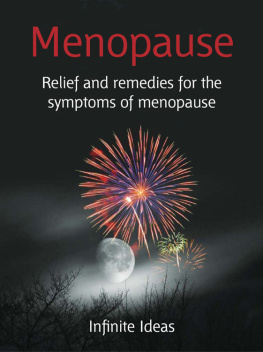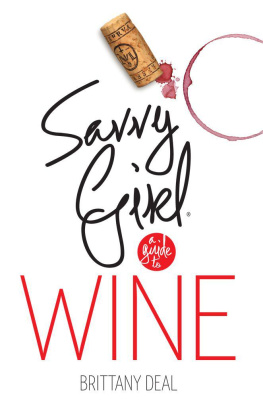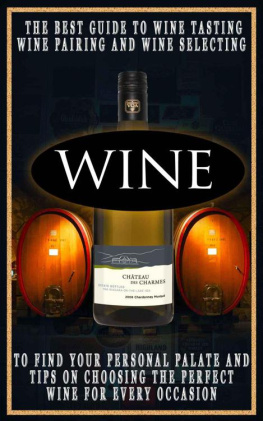Instant wine expert
Shortcuts to great wine choices
Infinite Ideas with Giles Kime
Previously published in paperback as The laid-back wine guide

8. Chardonnay
Chardonnay is now so ubiquitous that for some people it has become something of a joke. Yet the grapes come in such great diversity that it is hard to generalise about them.
Depending on where it is grown, Chardonnay can demonstrate a huge variety of traits, from a steely, minerally austerity to a big, buttery richness. Like any grape it can also make wines that are extremely bland and it is because of these that the better-quality examples have been given a bad name. But even when Chardonnay isnt well made it can still be much better than the basic examples of other white wines, such as Riesling or Sauvignon Blanc. It is perhaps this fact that has encouraged winemakers all over the world to make it their number one grape.
In the beginning there was Chablis, the most popular of all white Burgundies. Then the Australians wanted a piece of the action and during the 60s and 70s Chardonnay became increasingly popular. The Californians planted it too and during the 80s and 90s it rapidly appeared in wine regions from Chile to South Africa. Chardonnay is now one of the most successful, widely recognised grape varieties, which winemakers love for its adaptability and drinkers for its approachability.
As with any grape variety the only way to find your way round all the different styles is to put your nose and palate to work. A good introduction should include: expensive Chablis, expensive Californian Chardonnay, inexpensive oaky Australian Chardonnay, unoaked Australian Chardonnay and Hungarian Chardonnay.
There were doubtless times in this Taste Test when you wondered whether you were tasting the same grape. Chardonnnay grown in the relatively chilly climes of Burgundy will inevitably have very different character from one grown in the sunny climes of New South Wales. But it isnt just the weather that affects the flavour of a wine. So too does the way that it is made. Ask yourself some of the following questions. Were some of the wines sweeter or drier than others? Stronger and more robust? A little more acidic? Slightly creamier? Fruitier?
Heres an idea for you
Remember that when you are tasting the wines on the tasting menu you are doing so without food or perhaps nothing more enticing than a dry biscuit. If possible, crank up your tasting session by trying the wines with food. Examine how the different styles combine with the flavours of spicy food, fish and red meat.
9. Great whites
White wine doesnt begin and end with Chardonnay and Sauvignon Blanc. There are plenty of more obscure whites worth trying some of them toe-curlingly unfashionable but nevertheless extraordinarily delicious.
Riesling . No longer fashionable, although plenty of delicious examples still abound, both from Germany and increasingly from other cool climate regions such as New Zealand.
Gewurztraminer. A sublimely scented wine whose spiritual home is in Alsace.
Pinot Grigio/Gris . The thin whites of northern Italy (known as Pinot Grigio) have done much to ruin the reputation of a grape that in the right hands can produce rich scented wines that make ideal partners to Asian food.
Semillon . The classic white grape of Bordeaux is now grown all over the world, notably in Australia, where it produces whites that put their French ancestors to shame.
Viognier. In the Rhne Valley, Viognier makes wines with an almost mythical reputation. In the South of France and Australia it provides easy-drinking wines that make a good alternative to Chardonnay.
Verdelho . This obscure grape variety is now being used to make distinctive wines in Australia, particularly in the Hunter Valley in New South Wales.
Taste Test
Australian Verdelho Southern French Viognier Good-quality Australian Semillon New Zealand Pinot Gris Good-quality Alsace Gewurztraminer Good-quality dry Riesling Good-quality Chardonnay Good-quality Sauvignon Blanc.
You dont have to try all these wines at once. Four or five will suffice. The Chardonnay and Sauvignon have been included on the list so you have some familiar flavours and aromas to compare the more offbeat wines against. In each case consider the aroma, flavour, colour, how it might go with food and whether it would make a good aperitif.
The greater number of flavours and aromas youre aware of, the greater chance youll have of finding wines that serve a specific purpose such as an aperitif or offer a good match with food, and the more bottles you have open at any one time, the more opportunities youll have to compare them with different types of food and with one another.
Heres an idea for you
For a month challenge yourself to drink only white wines other than Chardonnay and Sauvignon Blanc. The more you taste around, the more happy discoveries youll make.
10. Grape expectations
Mastering the art of telling one grape from another is the easy bit. But, such is the intervention that goes on during the winemaking process, the really knotty question is whether grapes truly matter.
To demonstrate the diverse flavours that can be displayed by one grape variety, try a Taste Test on any of the following combinations:
- Burgundian Chardonnay + Australian Chardonnay
- Burgundian Pinot Noir + New Zealand Pinot Noir
- Loire Sauvignon Blanc + Chilean Sauvignon Blanc
- Sweet German Riesling + Australian dry Riesling
In most cases you will probably have found very different personalities demonstrated by the same grape and you might well be asking a question that is almost heretical in the brave new world of wine appreciation: How important are grapes?
To French traditionalists, the origin of a wine is far, far more important than its ingredients a belief that has much to do with the idea that wine is the product of soil and weather rather than grapes and winemaking. Many French winemakers would also argue that because some of their wines are made from a blend of three or four grapes the finished product is more important than the ingredients.
New World winemakers would beg to differ. For them, wine should be a shining example of the grape it was made from. Chardonnay should conform to the classic fruit and oak combination. Sauvignon Blanc should be fresh and zingy. Cabernet should be deep and berryish. Merlot should be soft and velvety. This, they believe, not only focuses the attention of the winemaker but also simplifies matters by offering the market recognisable names with a range of flavours and aromas that are easy to identify.
Although these two views appear to be contradictory, they arent necessarily mutually exclusive. There are some wines that express the place where they were made and others that express the grape they were made from.
Heres an idea for you
Try to familiarise yourself with the major grape varieties by always trying to guess which ones are in the wine you are drinking. Initially youll often get them wrong, but the more you focus on this skill, the more youll find your way.
11. Winemaking 101
If only wine consisted of nothing more than the fermented juice of grapes! In fact, theres a great deal of intervention in the winery, some good, some rather distasteful.
Much of what happens to grapes particularly those used to make cheap wines involves compensating for poor-quality grapes. If all grapes were grown in ideal conditions, there would be little need to do much more than crush them and then ferment the juice that remains and for very expensive wines, that is more or less what happens.
Next page


















